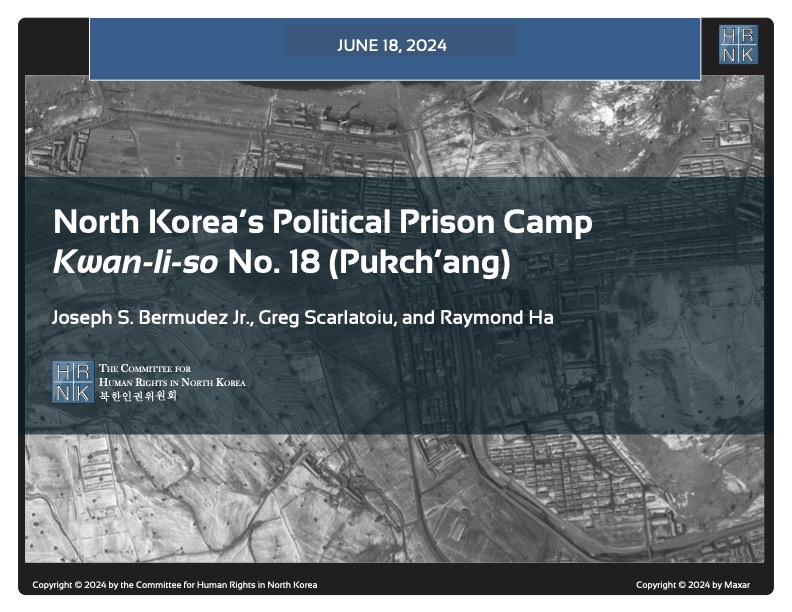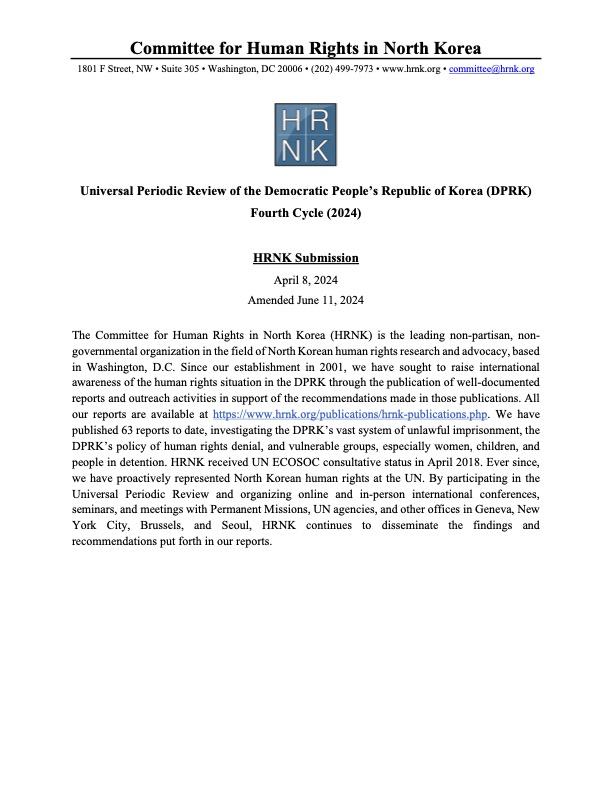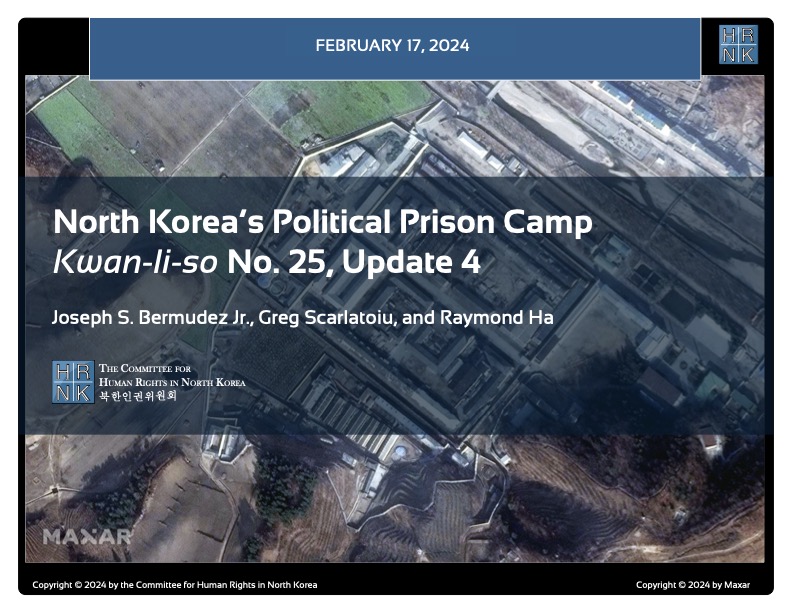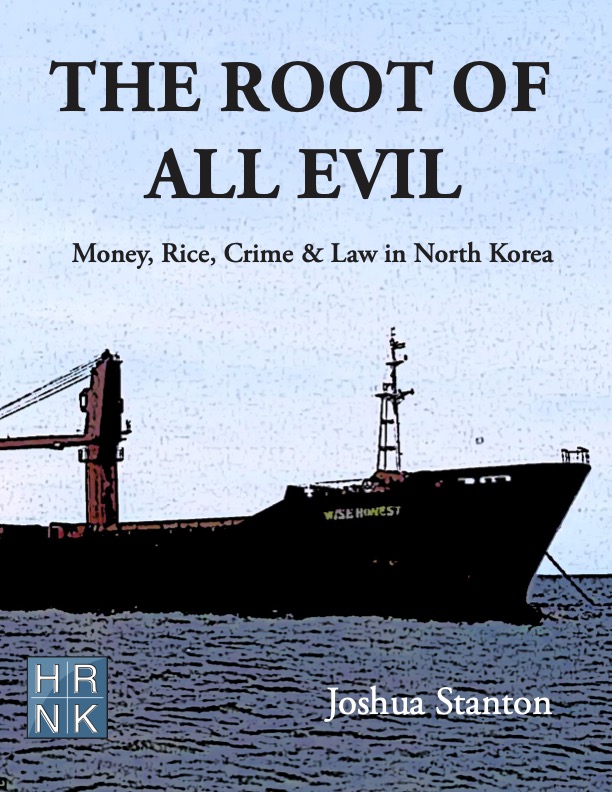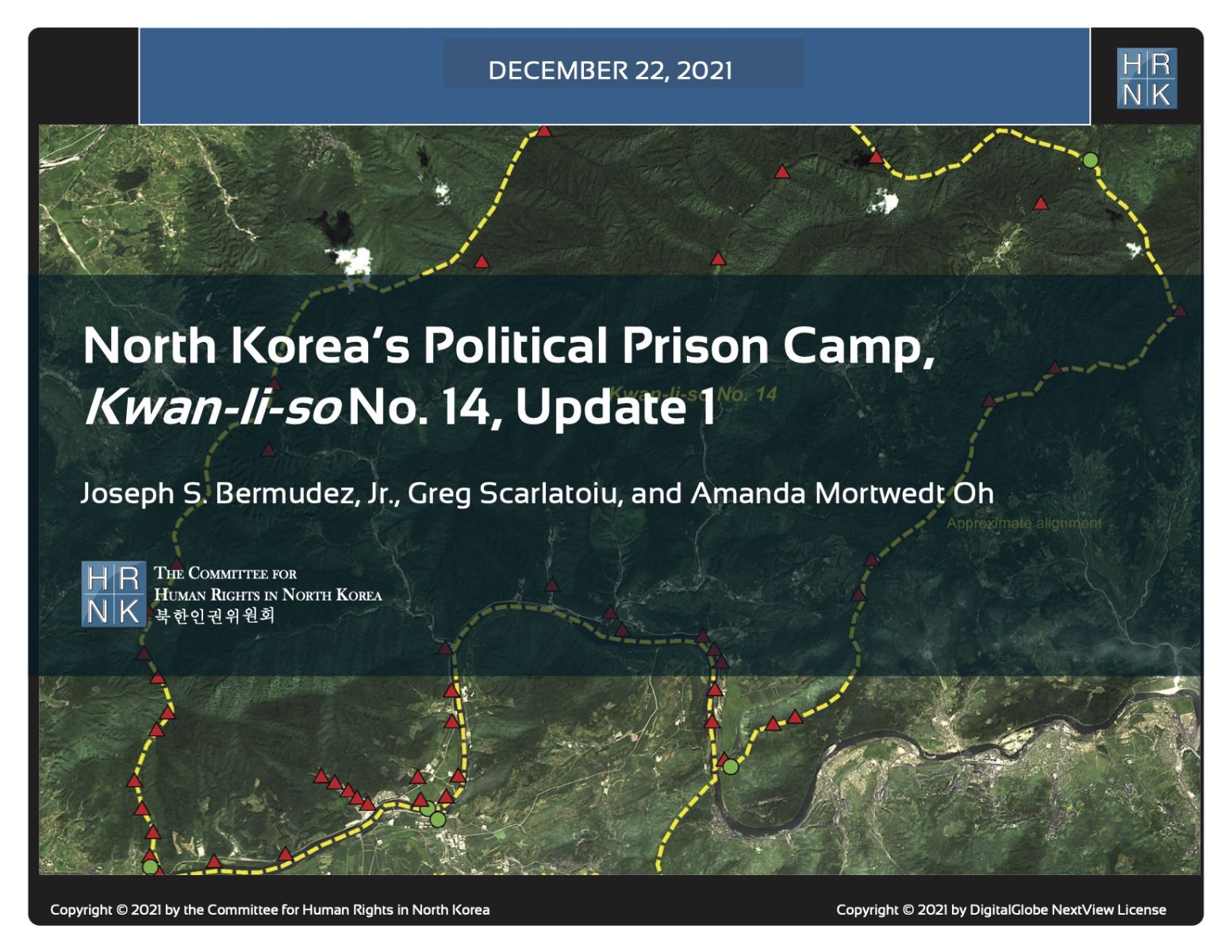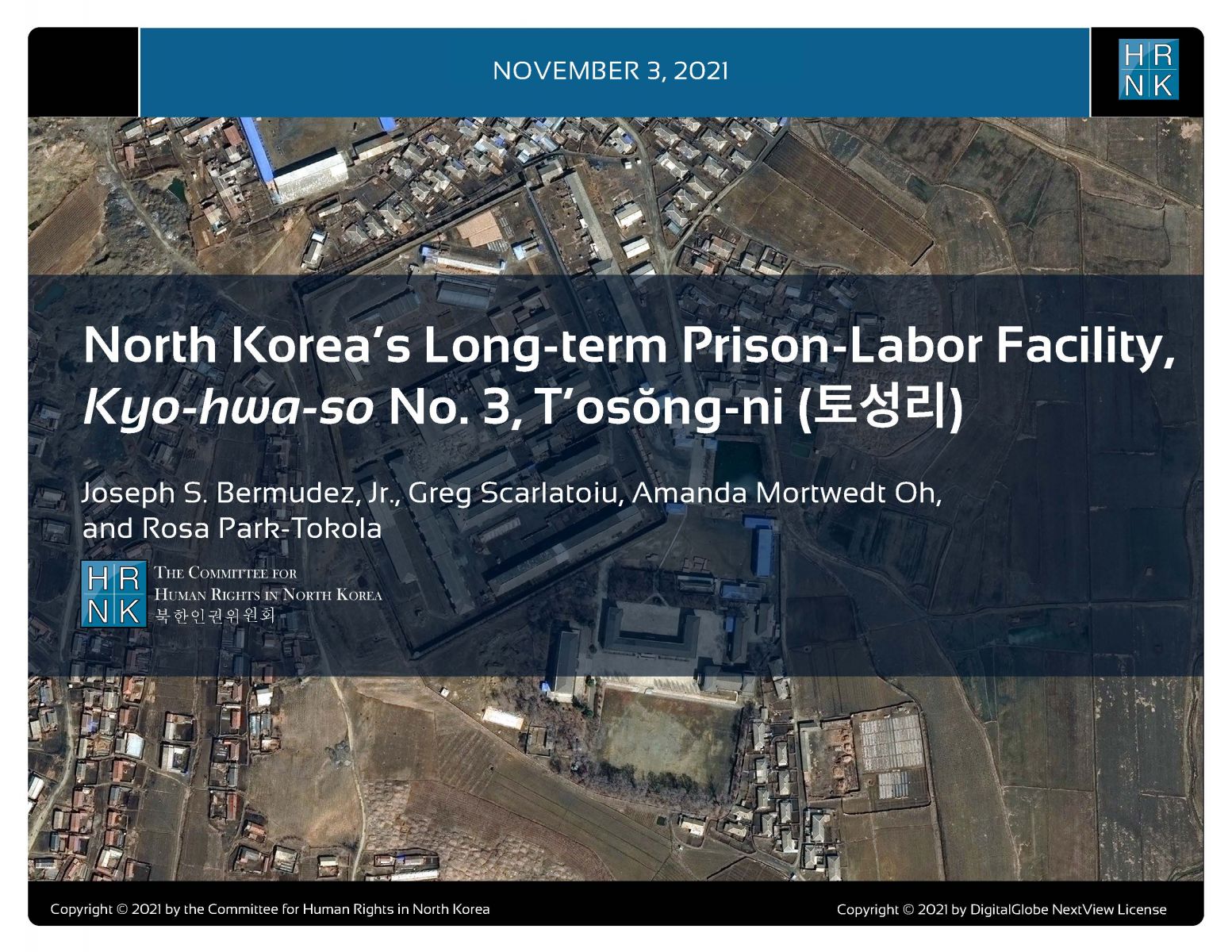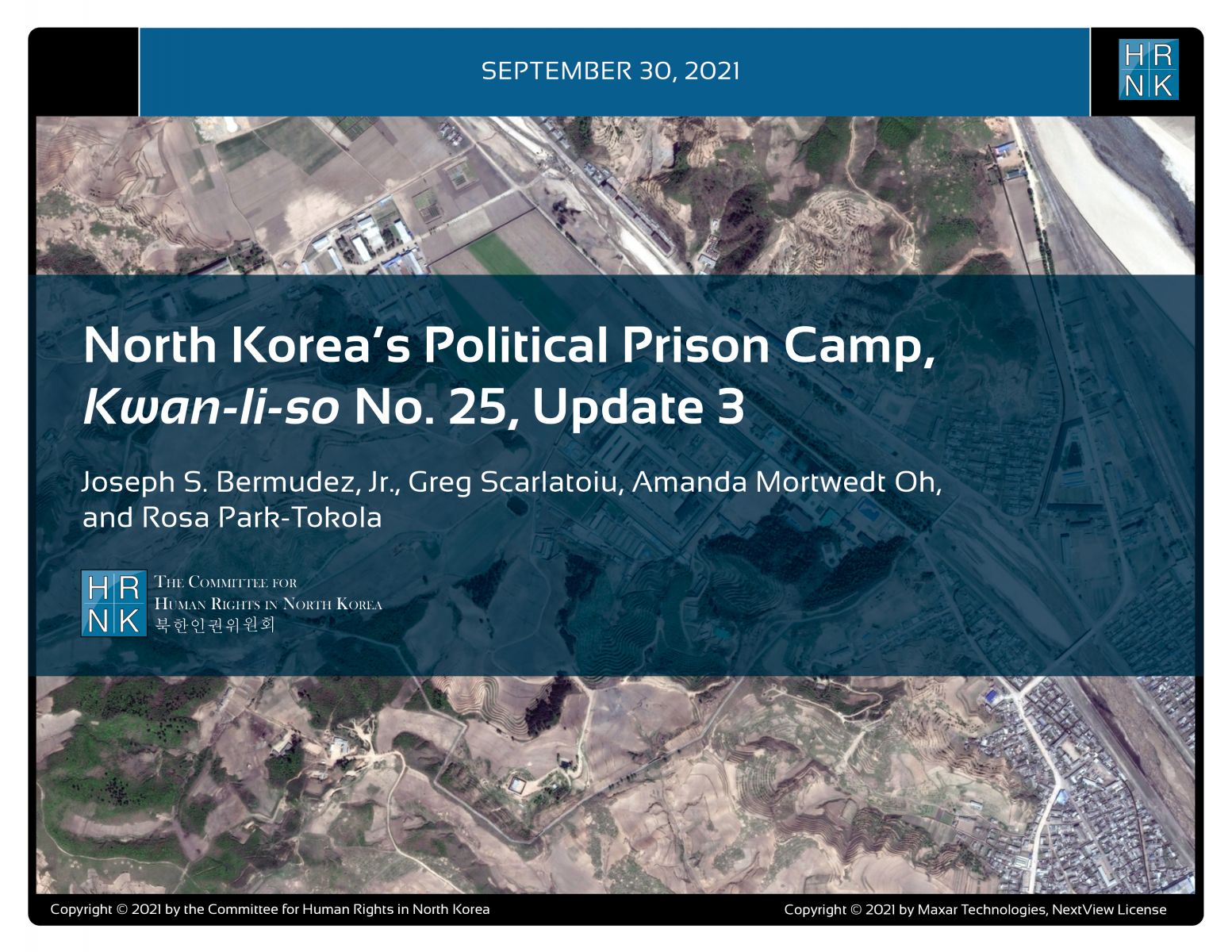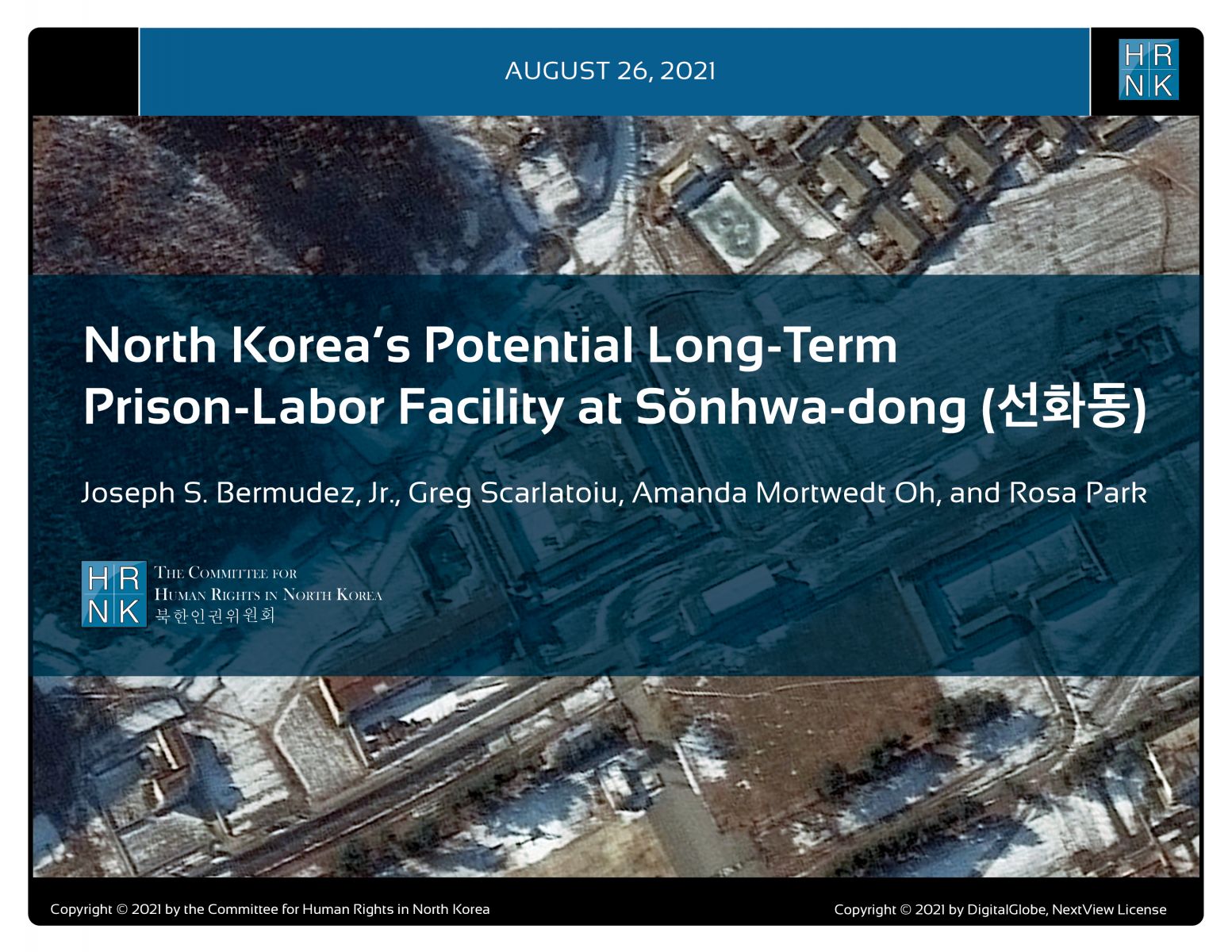PRESS RELEASE
Report Embargoed until 12:01 am EDT, Tuesday, August 27, 2013
HRNK Launches New Report: North Korea’s Hidden Gulag: Interpreting Reports of Changes in the Prison Camps
The Committee for Human Rights in North Korea (HRNK), a US-based non-governmental organization, has launched a new report by David Hawk, updating the current status of the North Korean political prison camp system. The report was made possible by funding from the Open Society Foundations (OSF). The report confirms the closure of two of North Korea’s known six political penal labor colonies, finding “extremely high” the total number of prisoners remaining incarcerated on political grounds, reported missing and unaccounted for, and who have died in detention. The report builds on the 2012 HRNK report Hidden Gulag Second Edition by the same author, drawing on recent satellite imagery analysis, interviews with former camp prisoners and guards as well as new sources of information within North Korea.
Through this vast system of unlawful imprisonment, the North Korean regime isolates, banishes, punishes and executes those suspected of being disloyal to the regime. They are deemed “wrong-thinkers,” “wrong-doers,” or those who have acquired “wrong-knowledge” or have engaged in “wrong-associations.” Up to 130,000 are known to be held in the kwan-li-so penal labor colonies where they are relentlessly subjected to malnutrition, forced labor, and to other cruel and unusual punishment. Thousands upon thousands more are forcibly held in other detention facilities. North Korea denies access to the camps to outsiders, whether human rights investigators, scholars, or international media and severely restricts the circulation of information across its borders.
In Camp No. 22 in Hoeryong, North Hamgyong Province, one of the two closed camps, the prison population is said to have dwindled dramatically prior to closure in 2012-2013 from 30,000 to between 3,000 and 8,000, reportedly due to severe food shortages inside the camps. “If even remotely accurate, this is an atrocity requiring much closer investigation,” concludes David Hawk.
HRNK’s report examines whether the dismantling of Camp No. 18 in Bukchang, South Pyongan Province, finalized in 2006, which resulted in the release and rehabilitation of all but a fraction of the inmates, could serve as “a precedent” for how the entire camp system could be ended.
“Through satellite imagery and eyewitness accounts, HRNK will continue to monitor the status of North Korea’s political prison camps, as it is essential to ensure that the North Korean regime not be allowed to erase evidence of atrocities or eliminate the surviving prisoners,” said Greg Scarlatoiu, HRNK Executive Director.
“An accounting of the fate and whereabouts of all of North Korea’s political prisoners, including those missing and those who have died in detention should be of highest priority to the UN commission of inquiry and the entire international community,” declared HRNK Co-Chair Roberta Cohen. “International arrangements should be negotiated for the entry of the International Committee of the Red Cross (ICRC) into the camps.”
HRNK’s 2012 report Hidden Gulag Second Edition recommended immediate access to the prison camps by the ICRC and the World Food Program. It contained information about all known political prison camps in North Korea and called for the creation of an international commission of inquiry to investigate North Korea’s breaches of international human rights law and international criminal law, concluding that massive crimes against humanity are being perpetrated in North Korea. Further it called on China to allow access by the UN High Commissioner for Refugees (UNHCR) to all North Koreans seeking refuge in China, and called on the United States, the Republic of Korea and Japan to integrate human rights concerns into any future normalization of political and economic relations with North Korea.
HRNK, established in 2001 by a distinguished group of foreign policy and human rights specialists, seeks to draw attention to human rights conditions in North Korea by publishing well-documented reports and papers, convening conferences, testifying at national and international fora, and seeking creative ways to end the isolation of the North Korean people. In its 2006 report Failure to Protect: A Call for the UN Security Council to Act in North Korea, HRNK became the first organization to propose the establishment of a UN Commission of Inquiry (CoI) on the human rights situation in North Korea.
The report’s author, David Hawk, is a prominent human rights researcher and advocate, a former Executive Director of Amnesty International USA, and a former United Nations human rights official, who investigated, documented, and analyzed the Khmer Rouge genocide in Cambodia and for over a decade has scrutinized North Korea’s vast system of unlawful imprisonment.
The report North Korea’s Hidden Gulag: Interpreting Reports of Changes in the Prison Camps, embargoed until 12:01 am EDT Tuesday, August 27, is available on HRNK’s website: www.hrnk.org
Contact: Greg Scarlatoiu, [email protected]; 202-499-7973
David Hawk: 732-793-3104; 718-644-2963
This is the first satellite imagery report by HRNK on a long-term political prison commonly identified by researchers and former detainees as Kwan-li-so No. 18 (Pukch'ang). This report was concurrently published on Tearline at https://www.tearline.mil/public_page/prison-camp-18.
To understand the challenges faced by the personnel who are involved in North Korea’s nuclear program, it is crucial to understand the recruitment, education, and training processes through the lens of human rights. This report offers a starting point toward that understanding. North Korea’s scientists and engineers are forced to work on the nuclear weapons program regardless of their own interests, preferences, or aspirations. These individuals may be described as “moder
In this submission, HRNK focuses its attention on the following issues in the DPRK: The status of the system of detention facilities, where a multitude of human rights violations are ongoing. The post-COVID human security and human rights status of North Korean women, with particular attention to sexual and gender-based violence (SGBV). The issue of Japanese abductees and South Korean prisoners of war (POWs), abductees, and unjust detainees.
This report provides an abbreviated update to our previous reports on a long-term political prison commonly identified by former prisoners and researchers as Kwan-li-so No. 25 by providing details of activity observed during 2021–2023. This report was originally published on Tearline at https://www.tearline.mil/public_page/prison-camp-25.
This report explains how the Kim regime organizes and implements its policy of human rights denial using the Propaganda and Agitation Department (PAD) to preserve and strengthen its monolithic system of control. The report also provides detailed background on the history of the PAD, as well as a human terrain map that details present and past PAD leadership.
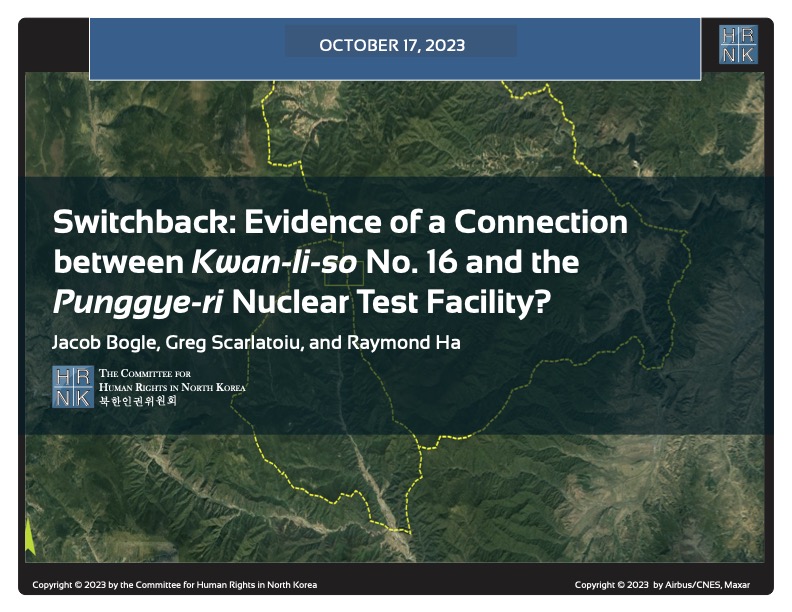
HRNK's latest satellite imagery report analyzes a 5.2 km-long switchback road, visible in commercial satellite imagery, that runs from Testing Tunnel No. 1 at North Korea's Punggye-ri nuclear test facility to the perimeter of Kwan-li-so (political prison camp) no. 16.
This report proposes a long-term, multilateral legal strategy, using existing United Nations resolutions and conventions, and U.S. statutes that are either codified or proposed in appended model legislation, to find, freeze, forfeit, and deposit the proceeds of the North Korean government's kleptocracy into international escrow. These funds would be available for limited, case-by-case disbursements to provide food and medical care for poor North Koreans, and--contingent upon Pyongyang's progress
For thirty years, U.S. North Korea policy have sacrificed human rights for the sake of addressing nuclear weapons. Both the North Korean nuclear and missile programs have thrived. Sidelining human rights to appease the North Korean regime is not the answer, but a fundamental flaw in U.S. policy. (Published by the National Institute for Public Policy)
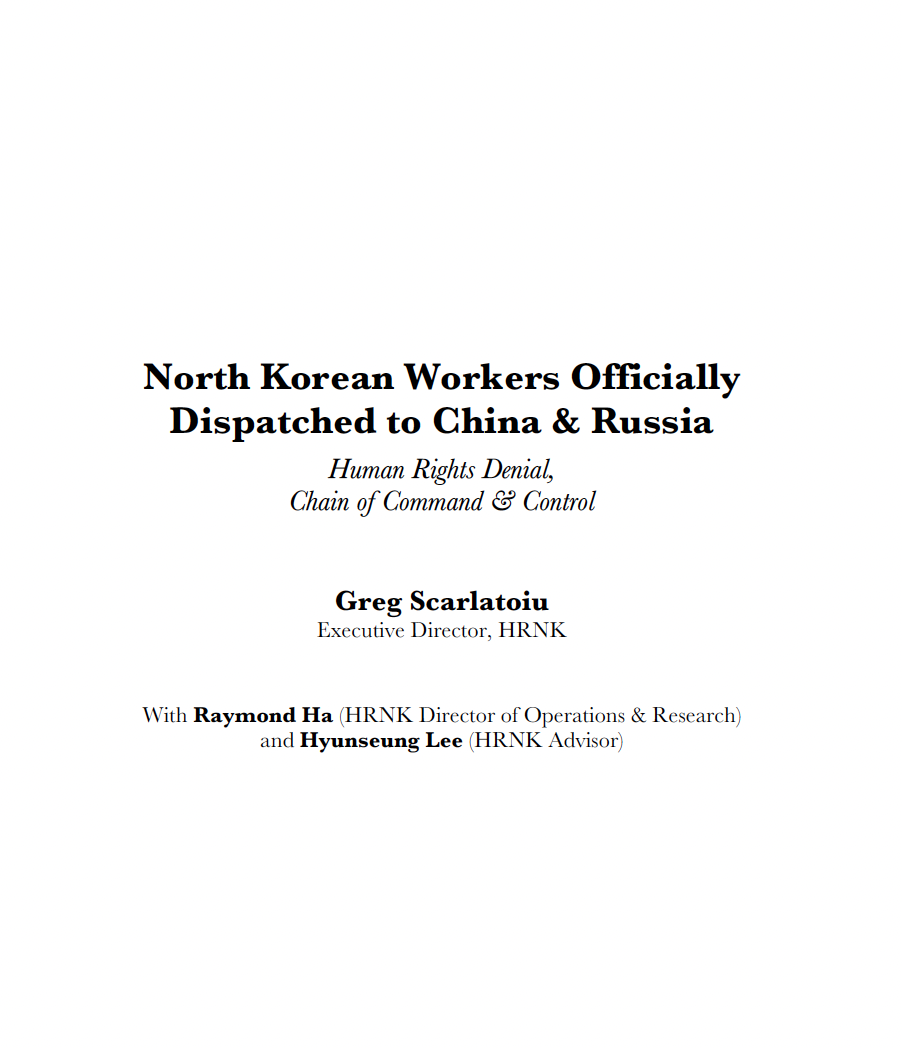
North Korea’s forced labor enterprise and its state sponsorship of human trafficking certainly continued until the onset of the COVID pandemic. HRNK has endeavored to determine if North Korean entities responsible for exporting workers to China and Russia continued their activities under COVID as well.
George Hutchinson's The Suryong, the Soldier, and Information in the KPA is the second of three building blocks of a multi-year HRNK project to examine North Korea's information environment. Hutchinson's thoroughly researched and sourced report addresses the circulation of information within the Korean People's Army (KPA). Understanding how KPA soldiers receive their information is needed to prepare information campaigns while taking into account all possible contingenc
This report is part of a comprehensive long-term project undertaken by HRNK to use satellite imagery and former prisoner interviews to shed light on human suffering in North Korea by monitoring activity at political prison facilities throughout the nation. This is the second HRNK satellite imagery report detailing activity observed during 2015 to 2021 at a prison facility commonly identified by former prisoners and researchers as “Kwan-li-so No. 14 Kaech’ŏn” (39.646810, 126.117058) and
This report is part of a comprehensive long-term project undertaken by HRNK to use satellite imagery and former prisoner interviews to shed light on human suffering in North Korea by monitoring activity at civil and political prison facilities throughout the nation. This study details activity observed during 1968–1977 and 2002–2021 at a prison facility commonly identified by former prisoners and researchers as "Kyo-hwa-so No. 3, T'osŏng-ni" and endeavors to e
This report is part of a comprehensive long-term project undertaken by HRNK to use satellite imagery and former detainee interviews to shed light on human suffering in the Democratic People’s Republic of Korea (DPRK, more commonly known as North Korea) by monitoring activity at political prison facilities throughout the nation. This report provides an abbreviated update to our previous reports on a long-term political prison commonly identified by former prisoners and researchers as Kwan-li-so
Through satellite imagery analysis and witness testimony, HRNK has identified a previously unknown potential kyo-hwa-so long-term prison-labor facility at Sŏnhwa-dong (선화동) P’ihyŏn-gun, P’yŏngan-bukto, North Korea. While this facility appears to be operational and well maintained, further imagery analysis and witness testimony collection will be necessary in order to irrefutably confirm that Sŏnhwa-dong is a kyo-hwa-so.
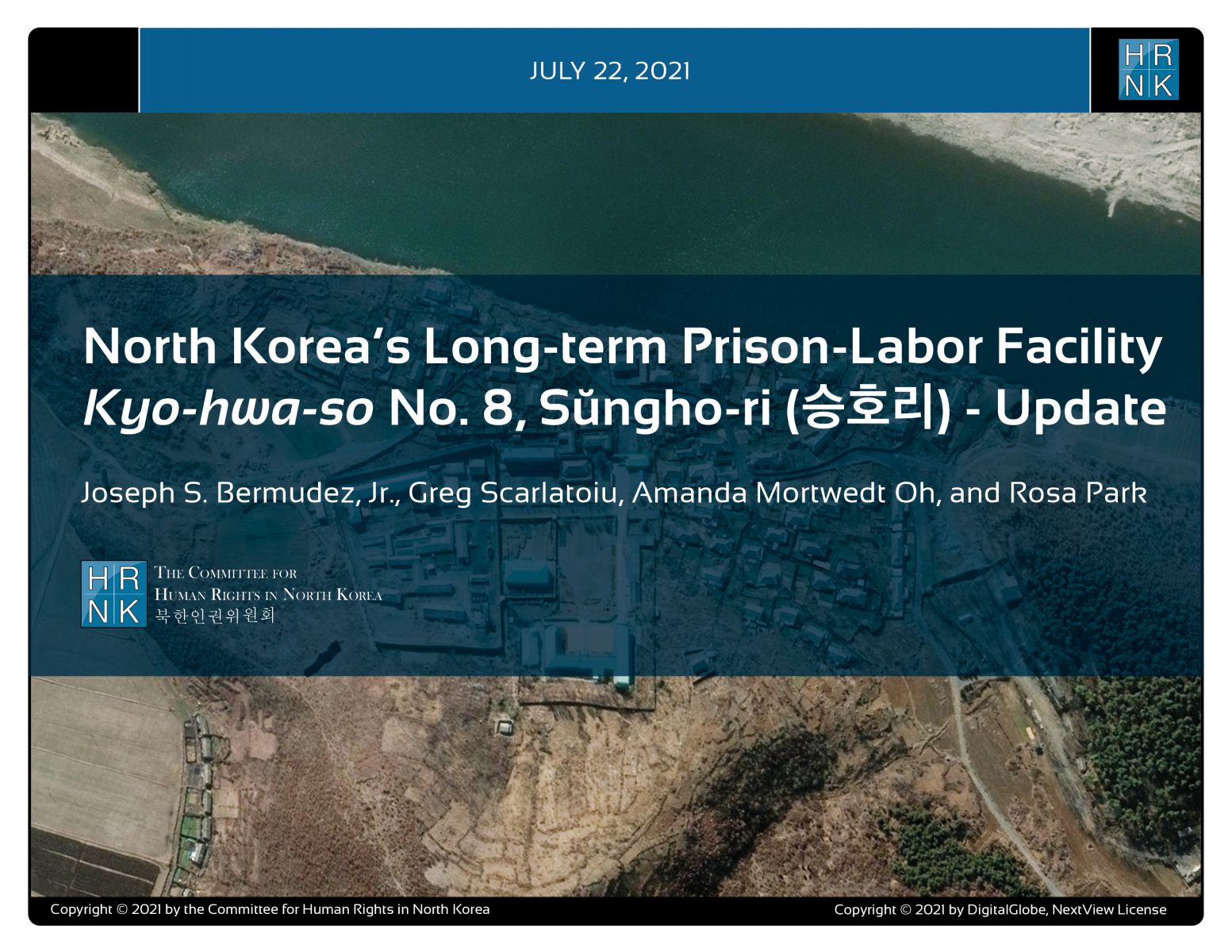
"North Korea’s Long-term Prison-Labor Facility Kyo-hwa-so No. 8, Sŭngho-ri (승호리) - Update" is the latest report under a long-term project employing satellite imagery analysis and former political prisoner testimony to shed light on human suffering in North Korea's prison camps.
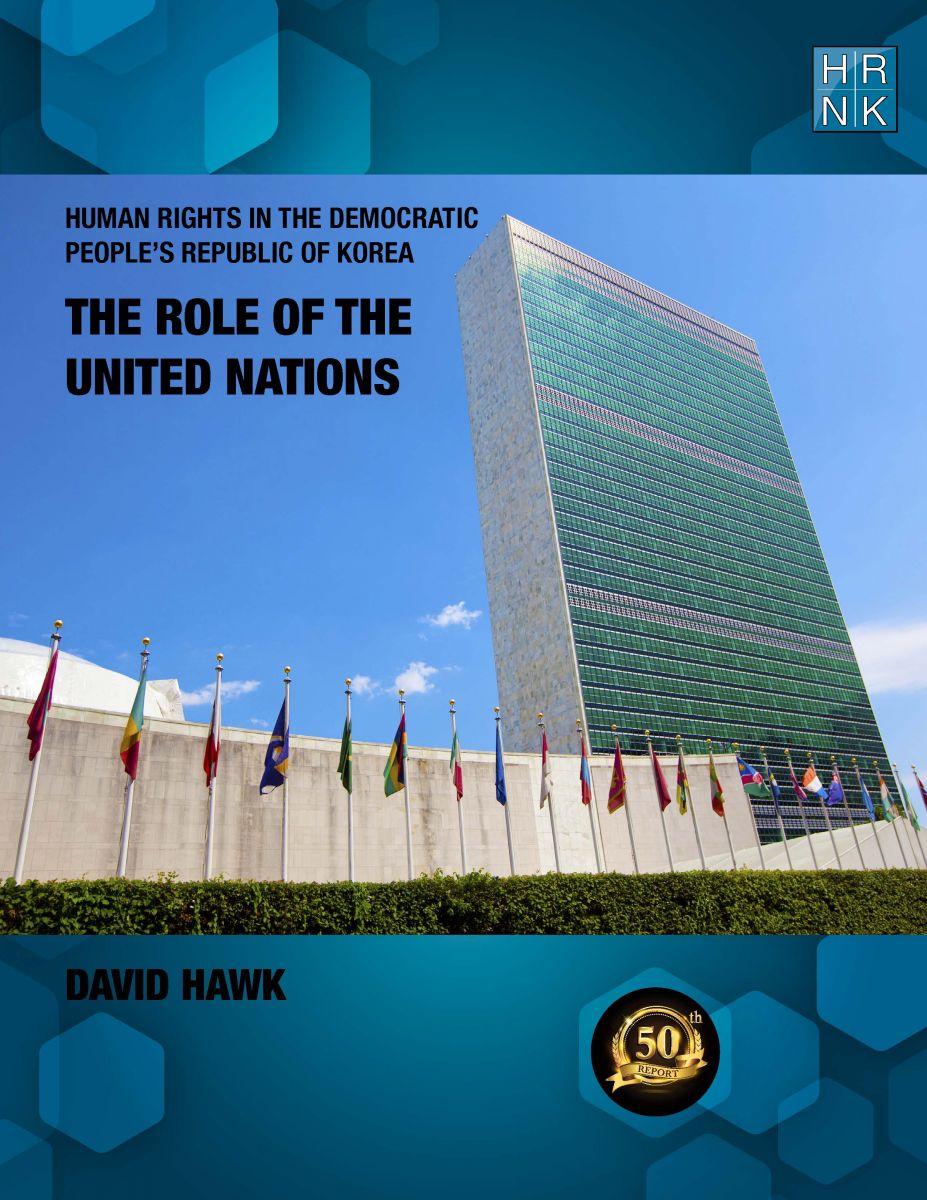
Human Rights in the Democratic Republic of Korea: The Role of the United Nations" is HRNK's 50th report in our 20-year history. This is even more meaningful as David Hawk's "Hidden Gulag" (2003) was the first report published by HRNK. In his latest report, Hawk details efforts by many UN member states and by the UN’s committees, projects and procedures to promote and protect human rights in the DPRK. The report highlights North Korea’s shifts in its approach
South Africa’s Apartheid and North Korea’s Songbun: Parallels in Crimes against Humanity by Robert Collins underlines similarities between two systematically, deliberately, and thoroughly discriminatory repressive systems. This project began with expert testimony Collins submitted as part of a joint investigation and documentation project scrutinizing human rights violations committed at North Korea’s short-term detention facilities, conducted by the Committee for Human Rights
